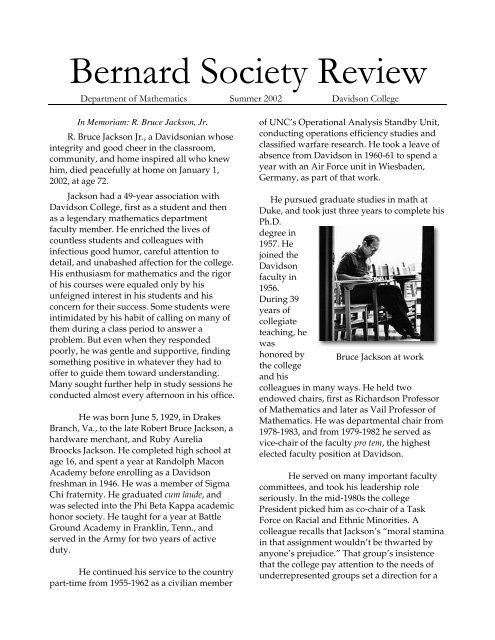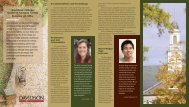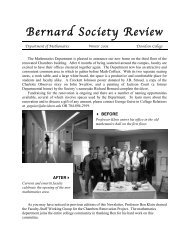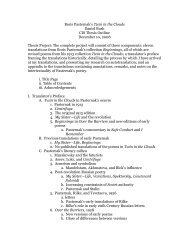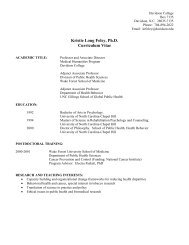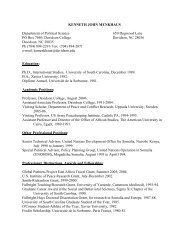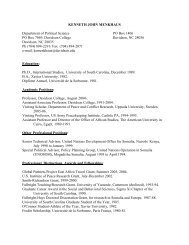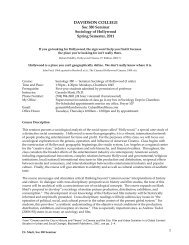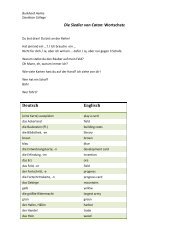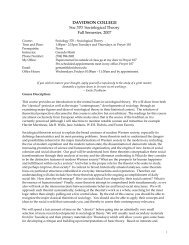Bernard Society Review - Davidson College
Bernard Society Review - Davidson College
Bernard Society Review - Davidson College
Create successful ePaper yourself
Turn your PDF publications into a flip-book with our unique Google optimized e-Paper software.
In Memoriam: R. Bruce Jackson, Jr.<br />
R. Bruce Jackson Jr., a <strong>Davidson</strong>ian whose<br />
integrity and good cheer in the classroom,<br />
community, and home inspired all who knew<br />
him, died peacefully at home on January 1,<br />
2002, at age 72.<br />
Jackson had a 49-year association with<br />
<strong>Davidson</strong> <strong>College</strong>, first as a student and then<br />
as a legendary mathematics department<br />
faculty member. He enriched the lives of<br />
countless students and colleagues with<br />
infectious good humor, careful attention to<br />
detail, and unabashed affection for the college.<br />
His enthusiasm for mathematics and the rigor<br />
of his courses were equaled only by his<br />
unfeigned interest in his students and his<br />
concern for their success. Some students were<br />
intimidated by his habit of calling on many of<br />
them during a class period to answer a<br />
problem. But even when they responded<br />
poorly, he was gentle and supportive, finding<br />
something positive in whatever they had to<br />
offer to guide them toward understanding.<br />
Many sought further help in study sessions he<br />
conducted almost every afternoon in his office.<br />
He was born June 5, 1929, in Drakes<br />
Branch, Va., to the late Robert Bruce Jackson, a<br />
hardware merchant, and Ruby Aurelia<br />
Broocks Jackson. He completed high school at<br />
age 16, and spent a year at Randolph Macon<br />
Academy before enrolling as a <strong>Davidson</strong><br />
freshman in 1946. He was a member of Sigma<br />
Chi fraternity. He graduated cum laude, and<br />
was selected into the Phi Beta Kappa academic<br />
honor society. He taught for a year at Battle<br />
Ground Academy in Franklin, Tenn., and<br />
served in the Army for two years of active<br />
duty.<br />
He continued his service to the country<br />
part-time from 1955-1962 as a civilian member<br />
of UNC’s Operational Analysis Standby Unit,<br />
conducting operations efficiency studies and<br />
classified warfare research. He took a leave of<br />
absence from <strong>Davidson</strong> in 1960-61 to spend a<br />
year with an Air Force unit in Wiesbaden,<br />
Germany, as part of that work.<br />
He pursued graduate studies in math at<br />
Duke, and took just three years to complete his<br />
Ph.D.<br />
degree in<br />
1957. He<br />
joined the<br />
<strong>Davidson</strong><br />
faculty in<br />
1956.<br />
During 39<br />
years of<br />
collegiate<br />
teaching, he<br />
was<br />
honored by Bruce Jackson at work<br />
the college<br />
and his<br />
colleagues in many ways. He held two<br />
endowed chairs, first as Richardson Professor<br />
of Mathematics and later as Vail Professor of<br />
Mathematics. He was departmental chair from<br />
1978-1983, and from 1979-1982 he served as<br />
vice-chair of the faculty pro tem, the highest<br />
elected faculty position at <strong>Davidson</strong>.<br />
He served on many important faculty<br />
committees, and took his leadership role<br />
seriously. In the mid-1980s the college<br />
President picked him as co-chair of a Task<br />
Force on Racial and Ethnic Minorities. A<br />
colleague recalls that Jackson’s “moral stamina<br />
in that assignment wouldn’t be thwarted by<br />
anyone’s prejudice.” That group’s insistence<br />
that the college pay attention to the needs of<br />
underrepresented groups set a direction for a
great deal of college action in that regard.<br />
Jackson also led colleagues in<br />
implementing a $250,000 Sloan Foundation<br />
grant, which was designed to<br />
incorporate<br />
technology and applied<br />
mathematics into the liberal<br />
arts curriculum. He worked to<br />
extend <strong>Davidson</strong>’s<br />
educational mission by<br />
spearheading Project Excel,<br />
which brought<br />
promising students from the<br />
Charlotte Mecklenburg<br />
System to campus for classes.<br />
His many college<br />
responsibilities created<br />
mounds of paperwork that<br />
covered every horizontal surface of his office,<br />
but Jackson kept them meticulously organized<br />
and accessible.<br />
In 1983 he received the college’s Thomas<br />
Jefferson Award for exhibiting through<br />
personal influence and teaching the highest<br />
example of personal and scholarly integrity. At<br />
the time he was cited as “A man of great<br />
accomplishment… who has lived his life so<br />
always to place the deed before the doer.”<br />
His family was always the center of his<br />
life, and from that base he extended his hands<br />
and heart in service to the wider community.<br />
He was an elder and choir member at<br />
<strong>Davidson</strong> <strong>College</strong> Presbyterian Church,<br />
president of the North Mecklenburg High<br />
PTSA, assistant treasurer for Our Towns<br />
Habitat for Humanity, and for several years<br />
was a regular driver for Safe Drive, a program<br />
which each weekend night provided<br />
Charlotte-area teenagers with a safe ride home<br />
when other means were not available. He was<br />
also a member of a<br />
longstanding group of<br />
friends who played<br />
contract bridge.<br />
The more leisurely<br />
pace, which followed his<br />
retirement in 1995,<br />
allowed him to pursue<br />
various pleasures. He<br />
enjoyed nurturing favorite<br />
plants and flowers,<br />
including the propagation<br />
of several hundred English<br />
boxwood plants whose<br />
origin was his maternal grandmother’s home<br />
in Drakes Branch. There was also time for<br />
travel with his wife of 40 years, Jean Ann<br />
Edwards Jackson, and friends. A highlight of<br />
his trips abroad was the discovery of<br />
moderately priced restaurants, and the meals<br />
enjoyed there. He was an active grandfather<br />
whose affectionate interest in his<br />
grandchildren was returned in full measure.<br />
Jackson was diagnosed with cancer in<br />
November 2000, and faced his fate and<br />
treatments with quiet valor. In their final<br />
months together, he and Jean made two<br />
vacation trips to Europe with friends, and<br />
celebrated their 40th anniversary at the beach<br />
with their children and grandchildren.<br />
(Thanks to Bill Giduz and the <strong>College</strong> Communications Office<br />
for this article.)<br />
Martha Key <strong>Bernard</strong>: 1920-2002<br />
Martha Key Brewer <strong>Bernard</strong>, 81, died January 20, 2002. Educated in the public schools of Clarksdale,<br />
MS, Stephens <strong>College</strong> in St. Louis, MO, and Randolph-Macon Women’s <strong>College</strong> in Lynchburg, VA, she<br />
married Richard <strong>Bernard</strong> in 1943. Living in Charlottesville, VA, and New Haven, CT, while Richard finished<br />
his Ph.D. and took up a post at Yale University, she came to <strong>Davidson</strong> in 1955. A loving wife, devoted mother,<br />
and friend, Mrs. <strong>Bernard</strong> was a member of DCPC, where she served as a Sunday School teacher and was<br />
active in many committees. A charter member of the Tuesday Book Club, she was also a member of Colonial<br />
Dames and the DAR. A memorial service was held Saturday, January 26, at DCPC.<br />
2
<strong>Bernard</strong> Lecture<br />
By Robert McLean ’03<br />
On October 3, 2001, the Department of<br />
Mathematics recognized mathematics majors,<br />
minors, and other students interested in<br />
mathematics at its annual <strong>Bernard</strong> Lecture. The<br />
keynote speaker was Dr. Carl Pomerance of Bell<br />
Laboratories, professor emeritus of the University<br />
of Georgia.<br />
The <strong>Bernard</strong> Lecture honors Dr. Richard<br />
<strong>Bernard</strong>, Professor of Mathematics at <strong>Davidson</strong><br />
from 1955 to 1983. Each year students, faculty<br />
and community members gather together for the<br />
Lecture as well as the reception and dinner<br />
preceding the talk.<br />
Chair Stephen Davis and <strong>Bernard</strong> <strong>Society</strong><br />
President Andy Schultz ’02 presided over a<br />
ceremony inducting Pomerance and members of<br />
the classes of 2002 and 2003 into the <strong>Bernard</strong><br />
<strong>Society</strong>. After a dinner honoring the new<br />
inductees, Pomerance presented his lecture, “Babe<br />
Ruth, Hank Aaron, Paul Erdös, and Me.”<br />
As with any good math talk, Pomerance<br />
opened with pictures and anecdotes. The pictures<br />
and anecdotes involved the life and<br />
accomplishments of the famous number theorist<br />
Paul Erdös. Pomerance next related several stories<br />
and accomplishments regarding Erdös that<br />
demonstrated the uniqueness and genius of the<br />
famous number theorist.<br />
Arguably Erdös’ most famous result<br />
involved the prime number theorem originally<br />
proved by Hadamard and de la Vallee Poussin.<br />
The proof involved complex analysis and it was<br />
later conjectured that any proof of the prime<br />
number theorem must involve complex analysis.<br />
That is, it was believed that there existed no<br />
elementary proof of the prime number theorem.<br />
However, Erdös and Selberg proved this<br />
conjecture false by providing an elementary proof.<br />
Pomerance next told a story involving a<br />
lecture given by the Polish mathematician Mark<br />
(l-r) Chair Stephen Davis, <strong>Bernard</strong> <strong>Society</strong> President<br />
Andy Schultz ’02, <strong>Bernard</strong> Lecturer Carl Pomerance,<br />
and <strong>Society</strong> inductee Cindy Moore ’03<br />
Kac. In his lecture, Kac made a conjecture<br />
regarding the density of a set of numbers with<br />
bounded prime divisors. Erdös was in the<br />
audience, and amazingly, before Kac had even<br />
completed his lecture, Erdös had discovered and<br />
written a proof of Kac’s conjecture.<br />
Next, Pomerance spoke about his<br />
relationship with Erdös. Pomerance recounted his<br />
first contact with Erdös—a letter in which Erdös<br />
claimed he could prove a conjecture posed by<br />
Pomerance and several colleagues. The conjecture<br />
involved the density of Ruth-Aaron Pairs.<br />
A Ruth-Aaron pair (a term coined by<br />
Pomerance and coauthors) refers to two<br />
consecutive positive integers with the peculiar<br />
property that the sum the prime factors of the<br />
consecutive positive integers is the same. That is,<br />
n and n+1 are a Ruth-Aaron pair if the sum of the<br />
prime factors of n is equal to the sum of the prime<br />
factors of n+1.<br />
Pomerance encountered the first Ruth-<br />
Aaron pair while watching a baseball game. In<br />
fact, it was the famous game in which Hank Aaron<br />
hit his 715 th homerun to surpass what was thought<br />
to be Babe Ruth’s unbreakable record of 714<br />
career homeruns. Watching the game, Pomerance<br />
noticed an unusual property of the numbers 714<br />
3
and 715, the property that the product of 714 and<br />
715 was the product of the first seven prime<br />
numbers. Pomerance challenged a colleague to<br />
find an unusual property of the two numbers 714<br />
and 715. His colleague discovered the same<br />
property of the two numbers, but not before posing<br />
the challenge to one of his classes.<br />
A student in his class discovered a<br />
different property of the two numbers: the<br />
property that the prime factors of 714 and 715 both<br />
summed to 29. Pomerance and his colleagues<br />
found other examples of consecutive numbers with<br />
this property and they named them Ruth-Aaron<br />
pairs.<br />
In their paper, Pomerance et al conjectured<br />
that the density of these Ruth-Aaron pairs is 0. In<br />
his letter to Pomerance, Erdös claimed that he<br />
could prove this conjecture, and this letter began a<br />
collaboration between Pomerance and Erdös that<br />
resulted in a life long friendship and several joint<br />
papers.<br />
Pomerance concluded his talk with several<br />
of the conjectures and results that appeared in<br />
these papers. He gave several justifications of<br />
why there should be infinitely many Ruth-Aaron<br />
pairs. In addition, he and Erdös established an<br />
upper bound on the number of Ruth-Aaron pairs<br />
occurring before a given number—a new result.<br />
As a corollary to this result, the two were able to<br />
determine that the series of reciprocals of numbers<br />
with Ruth-Aaron pairs converges.<br />
Next year’s <strong>Bernard</strong> Lecture will be given<br />
by Underwood “Woody” Dudley of Depauw<br />
University, author of five books, including<br />
Mathematical Cranks (1992) and Numerology<br />
(1997), and winner of several awards including<br />
the 1996 Trevor Evans Award (for expository<br />
writing) from the MAA.<br />
For more information, consult<br />
http://www.davidson.edu/math/<br />
Front row: Andra Whitt ’01, Gretchen Hamm ’02, Martha Peed ’03, Lesley Bowman ’80, <strong>Bernard</strong> Lecturer Carl<br />
Pomerance, Ashley Moore ’02; Back rows: Melanie Albert ’02, Rich Joiner ’03, Martin Turner ’04, Cindy Moore ’03,<br />
Katie Osbolt ’02, Mark Medendorp ’00, Megan Shafer ’03, Randy Skattum ’01, Ian Nelson ’02, Ashley Alderman ’03,<br />
Will Jordan ’02, Adriel Cornman ’03, Mike Harney ’02, Lang Robertson ’02, Alex Pow ’02, Matt Phillips ’02, Mary<br />
Hunter Wylie ’02, <strong>Bernard</strong> <strong>Society</strong> President-Elect Robert McLean ’03, Stanley Prybe ’02, James Daniel ’02, Ben<br />
Sargent ’02, <strong>Bernard</strong> <strong>Society</strong> President Andy Schultz ’02, Will Herring ’02, Carlos Carreras ’02<br />
4
Faculty News<br />
Professor Irl Bivens and Professor<br />
and Chair Stephen Davis are pleased that<br />
their work with Howard Anton has come to<br />
fruition—no less than five versions of the<br />
now Anton-Bivens-Davis Calculus, 7 th ed.,<br />
published by Wiley. Now they’re hard at<br />
work on the next iteration!<br />
Professor Davis also finished up a<br />
second three-year term as Secretary-Treasurer<br />
of the Southeastern Section of the MAA and<br />
helped organize the joint MAA-SE/AMS-SE<br />
meeting in Atlanta. This spring he became<br />
Chair-Elect of the Section.<br />
Stephen traveled to Cincinnati for the<br />
annual meeting of SIGCSE (Special Interest<br />
Group on Computer Science Education, of the<br />
Association for Computing Machinery). He and<br />
several others in the Department also participated<br />
in workshops last summer on Blackboard, a new<br />
program for class management over the web, and<br />
used it for his MAT 135 course.<br />
Professor Irl Bivens continues to edit the<br />
Problems and Solutions section of the <strong>College</strong><br />
Mathematics Journal with Richie King, Ben<br />
Klein, and Todd Will.<br />
Assistant Professor Laurie Heyer is<br />
working with <strong>Davidson</strong> biology professor<br />
Malcolm Campbell to put the finishing touches on<br />
their textbook, Discovering Genomics, Proteomics<br />
and Bioinformatics, to be published in August.<br />
Other activities related to her interests in<br />
computational biology include teaching a seminar<br />
course, doing summer research with Adam Abele<br />
'03, and speaking at the Duke University<br />
mathematics seminar.<br />
Laurie is thrilled that the Patterson Court<br />
Council voted this spring to adopt the solution to<br />
assigning women to eating houses that her<br />
operations research class developed last spring.<br />
Students Anthony Albert ’01, Tim Valdes ’01, and<br />
Mary Hunter Wylie ’02 worked on this project,<br />
and Laurie met with PCC representatives this year<br />
to explain how the method would work.<br />
Laurie and husband Bill stay busy rooting<br />
for the Wildcats and keeping up with their new<br />
The usual suspects (l-r): Laurie Heyer, Irl Bivens, Donna Molinek, Rich<br />
Neidinger, Stephen Davis, John Swallow, Ben Klein, <strong>Bernard</strong> Lecturer Carl<br />
Pomerance, Rob Whitton ‘66, Todd Will, and Richie King ‘59.<br />
Border Collie puppy Addie. They have also begun<br />
to explore North Carolina, including the Smokies<br />
and the Outer Banks.<br />
Richardson Professor Richie King ’59<br />
retired at the end of this academic year. He offers<br />
the following response to the question, “What are<br />
you going to do in retirement?”:<br />
The short version is NOTHING. Beyond<br />
nothing: we are moving back into town from the<br />
lake, so there is a new garden spot to be worked. I<br />
do have a couple of projects with mathematical<br />
content I will work on. Lots of pleasure reading,<br />
most of it low brow stuff. Did I mention our<br />
grandson James? A nice prospect, retirement.<br />
Congratulations, Richie!<br />
Dolan Professor Ben Klein continues to<br />
serve on the Advanced Placement Calculus<br />
Committee of the <strong>College</strong> Board. The Committee<br />
is now charged with preparing seven different free<br />
response examinations—AB and BC exams for<br />
Europe, AB and BC (operational) exams for the<br />
continental United States, AB and BC (alternate)<br />
exams for the continental United States, and an<br />
AB exam for Alaska-Hawaii.<br />
He also gave an invited presentation<br />
entitled “Probabilistic Paradoxes” during the<br />
Virginia Episcopal School’s Paideia Program on<br />
April 15.<br />
5
The 2001-2002 school year has been an<br />
interesting one for Associate Professor Donna<br />
Molinek. Last fall, she taught the department’s<br />
Finite Math class, commenting on more than one<br />
occasion, “Wow!” She says it was a special<br />
challenge to teach such interesting mathematics to<br />
students who were inclined toward other<br />
disciplines. She’ll try again next spring.<br />
After living in <strong>Davidson</strong> for almost 10<br />
years, Donna and her family finally made it to<br />
Charleston! Donna gave a talk about Stephen<br />
Smale and his Horseshoe at the <strong>College</strong> of<br />
Charleston; afterwards, the Molineks enjoyed a<br />
fun weekend.<br />
Donna also helped coordinate the<br />
congregational retreat April 12-14 for <strong>Davidson</strong><br />
<strong>College</strong> Presbyterian Church. During that weekend<br />
in Montreat, daughter Sullivan turned 5. Sullivan<br />
and her 8.5-year-old brother Rudy celebrated by<br />
rock hopping and building dams in the creek.<br />
For fun, Donna is taking pottery lessons<br />
with a local artist and elementary school teacher<br />
and is working on making Möbius bands, knot and<br />
link sculptures, and wheel-thrown pots. Donna<br />
reports that she and Laurie Heyer again put in<br />
respectable finishes in the Town Day 5K,<br />
improving their times over last year.<br />
Professor Richard Neidinger took full<br />
advantage of a year on sabbatical for research,<br />
travel, and even some Spanish study. His research<br />
in numerical methods developed improvements in<br />
the most efficient way to compute multivariable<br />
Taylor series. His travels took him to central<br />
England, San Diego, Atlanta, Toronto, and the<br />
Yucatan peninsula in Mexico.<br />
In England, Rich gave the opening talk for<br />
the Joint Symposia in Automatic Differentiation.<br />
The Symposia is organized by Cranfield<br />
University at the Royal Military <strong>College</strong> of<br />
Science and the University of Hertfordshire. He<br />
visited both schools, working with Applied<br />
Mathematics and Computer Science faculty for<br />
much of the month of November. His family was<br />
able to join him for Thanksgiving in London. San<br />
Diego, Atlanta and Toronto were conference sites<br />
where he gave presentations on his work.<br />
Rich was in the Yucatan for the<br />
groundbreaking of a boarding school that will<br />
make secondary education accessible for children<br />
in the local Mayan villages. At the ceremony,<br />
attended by around a thousand villagers, he had<br />
the honor of representing the American churches<br />
that are supporting the project. (Contact Rich if<br />
you want to know more.)<br />
The trip motivated Rich to audit a SPA<br />
101 class at <strong>Davidson</strong> this year, and he learned just<br />
how hard students work in such an intensive firstyear<br />
class! In the fall, he felt just like a Calculus I<br />
student that comes in with no previous study of the<br />
subject. Since he couldn’t complete the course<br />
due to his travels, he started over in the spring and<br />
felt like the more experienced Calculus I students.<br />
From either perspective, learning is a great<br />
opportunity!<br />
Kimbrough Associate Professor John<br />
Swallow participated in the 2001 AP Calculus BC<br />
reading in June and then promptly left for two<br />
weeks in France, attending the XXII Journées<br />
Arithmétiques and then a more specialized<br />
conference, Modules Galoisiens en Géométrie<br />
Arithmétique, in Lille.<br />
Two of John’s papers saw publication, in<br />
the Transactions of the AMS and in<br />
Communications in Algebra. He was named an<br />
Associated <strong>College</strong>s of the South Technology<br />
Fellow, for work on Mathematica and Maple<br />
packages to support an undergraduate course in<br />
Galois theory. At the end of this academic year he<br />
was gratified to learn of the award of a Young<br />
Investigator Grant from the National Security<br />
Agency, which will support his research during<br />
2002 and 2003.<br />
Associate Professor Todd Will has taken a<br />
one-year leave from <strong>Davidson</strong> in order to begin<br />
teaching at the University of Wisconsin at La<br />
Crosse. Todd and his wife, Heather Hulett,<br />
accepted two positions in the Department of<br />
Mathematics at UW-L. We wish Todd and<br />
Heather all the best as they return to the Midwest.<br />
Faculty and first-year students continue to<br />
value the service of Visiting Assistant Professor<br />
Rob Whitton ’66 as a calculus instructor. This<br />
fall Rob has also enjoyed teaching a course in<br />
differential equations.<br />
Faculty and staff from departments at the<br />
<strong>College</strong> also celebrated the marriage of Frances<br />
Alexander, our departmental assistant, and Gerald<br />
Scott at a ceremony on December 8, 2001,<br />
expressing congratulations and hearty good wishes<br />
to both.<br />
6
Mossinghoff Joins<br />
Department<br />
The<br />
Department of<br />
Mathematics is<br />
pleased to<br />
announce that<br />
Michael<br />
Mossinghoff, a<br />
mathematician<br />
with extensive<br />
experience in<br />
computer<br />
science, has<br />
accepted our<br />
offer to join the<br />
Department as an<br />
Assistant Professor in the fall of 2002.<br />
Michael Mossinghoff<br />
Mossinghoff’s research expertise lies in<br />
the area of number theory and computational<br />
number theory, especially in the mathematics<br />
surrounding Lehmer’s Conjecture. After<br />
completing a master’s degree in computer science<br />
at Stanford in 1988 and a doctorate in mathematics<br />
at the University of Texas in 1995, he taught at<br />
Appalachian State University and then in the<br />
Program in Computing at UCLA. The recipient of<br />
teaching awards at Texas and Stanford and an<br />
occasional visitor at the Centre for Experimental<br />
and Constructive Mathematics at Simon Fraser<br />
University and the University of British Columbia,<br />
Michael will increase our offerings in computer<br />
science while supporting our core mathematics<br />
courses.<br />
For the coming year Michael is slated to<br />
teach linear algebra, object-oriented programming,<br />
data structures and algorithms, and a seminar in<br />
cryptography. For additional information, see<br />
Michael’s home page at UCLA this summer:<br />
http://www.math.ucla.edu/~mjm/<br />
The <strong>Bernard</strong> <strong>Society</strong> was<br />
active this year, hosting<br />
numerous math coffees as well<br />
as gathering for a fall picnic at<br />
Rob Whitton’s house and for a<br />
spring picnic at the Lake<br />
Campus.<br />
We heard several talks from<br />
mathematicians outside the department, including<br />
Tom McGintee ’01 and Tim Valdes ’01 who<br />
(along with current student Will Herring ’02)<br />
presented “Tales from the Job Front”; Bruce<br />
Bacon ’90 and Stephanie Eichenbrenner ’99,<br />
who described a career in teaching; and Joe<br />
Rusinko ’01, who discussed elliptic curves and<br />
coding theory. Crista Coles of Elon University<br />
spoke about reducing noise in images and<br />
functions with applications to heat conduction<br />
problems.<br />
We were delighted to hear about the<br />
summer research experiences of students Andy<br />
Schultz ’02, who studied graph theory at the<br />
University of Idaho, and Melanie Albert ’02, who<br />
studied Platonic solids and Cayley graphs at<br />
Lafayette <strong>College</strong>. Students of Professor King’s<br />
geometry class described “A Strange New<br />
Universe” in the fall. Andy Schultz ’02 and<br />
Robert McLean ’03 followed up in the spring<br />
with details of their independent study in<br />
projective geometry with Richie. Professor Will’s<br />
Theory of Computation class, consisting of Mike<br />
Harney ’02, Will Jordan ’02, and Ian Nelson<br />
’02, showed us how to analyze the Top-Spin<br />
puzzle.<br />
Several students, faculty, and Professor<br />
emeritus J.B. Stroud, took a road trip to hear<br />
Professor Swallow speak at the North Carolina<br />
State Dinner at Greensboro <strong>College</strong>.<br />
Finally, the faculty did their part.<br />
Professor Davis guided us in computing with a<br />
compass; Professor Heyer discussed mathematical<br />
problems in genomics; Professor Neidinger<br />
described the breakthroughs he has made in his<br />
7
esearch in numerical analysis; Professor Molinek<br />
discussed the behavior of the Smale horseshoe<br />
map; and Professor Klein challenged our intuition<br />
with probabilistic paradoxes. We also heard from<br />
Professor Ulrich Meyer of the Department of<br />
Philosophy on “Philosophy of Mathematics,” and<br />
Professor Wolfgang Christian of the Physics<br />
Department, who demonstrated the usefulness of<br />
Java for math and science students.<br />
<strong>College</strong> Receives<br />
Gift in King’s<br />
Honor<br />
On the eve of Richie King ’59’s retirement<br />
from active teaching, the Kimbrough family has<br />
established a professorship in his name. The L.<br />
Richardson King Professorship will be accorded to<br />
an exceptional pre-tenured faculty member. This<br />
professorship will aid <strong>Davidson</strong> <strong>College</strong> in<br />
attracting and retaining the finest faculty.<br />
Alumni Notes<br />
This year we surveyed<br />
odd-year graduates. We’ll start<br />
with graduates from the 30’s:<br />
Richard N. Aycock, Jr.<br />
’39 now rents small business<br />
properties after a career including<br />
teaching in Rowan County,<br />
working in insurance and for the<br />
Weather Service, and 30 years in<br />
the propane gas business.<br />
English Walker ’39, a<br />
retired pediatrician, lives at the Pines at <strong>Davidson</strong>.<br />
Forties: William R. Merritt ’47, formerly<br />
Vice-President of Roanoke Iron & Bridge Works, Inc.,<br />
enjoys tennis and working on property improvement<br />
projects. He spends time at the beach, watching<br />
grandchildren play ball, and visiting the <strong>Davidson</strong><br />
<strong>College</strong> campus at least once a year.<br />
Fifties: Richard E. Hodel ’59 continues to<br />
teach mathematics at Duke University and pursue<br />
research interests in set-theoretic topology. He enjoys<br />
racquetball, hiking, gardening, and reading, especially<br />
Trollope.<br />
Sixties: Jerry Vaughan ’61 was invited to<br />
address the Ninth Prague Topological Symposium, in<br />
the Czech Republic. Director of graduate studies for the<br />
Department of Mathematical Sciences at UNC-<br />
Greensboro since 1995, Jerry is Editor-in-Chief of<br />
Topology and its Applications and has edited the<br />
Handbook of Set-theoretic Topology.<br />
Paul Duvall ’63, Professor of Mathematical<br />
Sciences at UNCG, is a consultant for the Department of<br />
Defense.<br />
Robert R. Llewellyn ’63 is the Dean of the<br />
<strong>College</strong> and Associate Professor of Philosophy at<br />
Rhodes <strong>College</strong>.<br />
Barry A. Teague ’65 continues work as a<br />
financial planner.<br />
Thomas C. Leslie ’67, Executive Director of<br />
American Council of Engineering Companies of<br />
Georgia, is happily living in an old Victorian home in<br />
downtown Atlanta.<br />
Seventies: Narayanan Ramachandran ’71 is<br />
one of the principals of TYX Corporation, which<br />
develops software to diagnose safety-critical systems on<br />
aerospace and military equipment. He travels the world<br />
in search of new markets.<br />
Robert A. Potter ’73 is a Life Insurance<br />
Actuary with the North Carolina Department of<br />
Insurance.<br />
George Thomas ’73 is principal architect with<br />
Melville Thomas Architects. A Virginia Tech Master’s<br />
of Architecture graduate in 1979, he loves watching<br />
baseball and playing tennis, and has even started to play<br />
golf. He and Laura have two boys, Josh (14) and Willie<br />
(11), and live in Baltimore, MD.<br />
Bob Lautensack ’75 has worked as an actuary<br />
with the Phoenix Life Insurance Company for over 26<br />
years, having completed actuarial exams in 1980. He<br />
reports his most recent major activity as spearheading<br />
the company’s change from a mutual life insurance<br />
company to a stockholder-owned company.<br />
Cathy Ramos ’77 is currently working in<br />
training and education, particularly SAP<br />
implementation, at the Coca-Cola Company.<br />
Katherine Whitney ’79 is owner of Warren<br />
Whitney and Sherwood, a business management firm in<br />
Richmond, Virginia. Her main interests include 4- and<br />
6-year-olds, Ross and Elizabeth. Sam Abrosh, her<br />
husband, teaches physical chemistry at the University of<br />
Richmond.<br />
Eighties: Peter W. Jones ’83 reports teaching<br />
AP Calculus (AB and BC), International Baccalaureate<br />
Higher Mathematics, as well as Theory of Knowledge,<br />
8
at the IB School at North Miami Senior High. He is<br />
married to Magda and has a 3-year-old son Angel. Peter<br />
models his lectures after Richard <strong>Bernard</strong>, Bruce<br />
Jackson ’50, and Richie King ’59, and he cites Stephen<br />
Davis for inspiration in helping him stick with it!<br />
Mickey McDonald ’87,<br />
Associate Professor of Mathematics<br />
at Occidental <strong>College</strong>, served as<br />
Interim Dean of Students in 2000-<br />
2002. He also worked with<br />
President Mark Collier at Baldwin-<br />
Wallace in Cleveland, Ohio, as an<br />
American Council on Education<br />
Fellow in 2001-2002. His partner<br />
of 10 years, Tim Aaron, works for Blackboard, Inc.<br />
They jointly own a home in Los Angeles.<br />
Early nineties: Hayler Osborn ’93 trades<br />
options on the Pacific Stock Exchange. After college,<br />
he spent 3 years as a professional blackjack player and a<br />
year as a poker player!<br />
Tighe Crovetti ’95 recently took a new<br />
position as Senior Actuarial Analyst with PMA<br />
Insurance Group in Blue Bell, PA. Tisha and Tighe<br />
welcomed Ethan Francis, born May 11, 2001. They are<br />
now in a newly-built house in Skippack, PA.<br />
Mindy Davis ’95 lives in Charlotte, working as<br />
a Java programmer for an Internet startup and loving it!<br />
Rebecca Hardin ’95 is Controller for the law<br />
offices of Alan S. Gordon, P. A., in Philadelphia. She is<br />
also the happy owner/mother of four Siberian Huskies<br />
and, more importantly, will be celebrating her third<br />
wedding anniversary in April.<br />
Dhruv Mubayi ’95 finished a one-year<br />
research postdoc at Microsoft Research and begins in a<br />
tenure-track position at the University of Illinois at<br />
Chicago in the fall.<br />
Henry Neale ’95 teaches mathematics at<br />
Country Day in Charlotte. He obtained a master’s in<br />
mathematics education and is currently pursuing his<br />
Ph.D. in the same subject.<br />
Jalyn Parsley Wells ’95 teaches Algebra II,<br />
Geometry and Pre-Calculus, grades 9-12, at the<br />
Greenhill School in Addison, Texas, near Dallas. She<br />
and Chris Wells ’95 celebrated four years of marriage.<br />
Late nineties: Greg Garrison ’96 works for<br />
Bank of America in Charlotte. He and Dannon<br />
welcomed son Augustus to the world in July, 2001.<br />
Chloe Bracis ’97 is engaged to be married in<br />
Seattle, with Maria Moré ’97 as maid of honor. Maria<br />
continues her work in equity derivatives research with<br />
Goldman Sachs in NYC.<br />
Amy Scalcucci ’97 finished dental school at<br />
the University of Kentucky. In spare moments she’s<br />
helped with the dental needs of the working poor and<br />
has mentored high school kids.<br />
Meredith Strong ’97, an Army<br />
Communication Officer for a helicopter battalion in<br />
Germany, is leaving the military as a Captain. She is<br />
pursuing a M.S. degree and has secured a position in the<br />
State Department in the Foreign Service.<br />
Tanner Thompson ’97 is Senior Analyst for<br />
Petroleum Market & Trading at El Paso Energy in<br />
Houston.<br />
Scott Young ’97 finished his Ph.D. in<br />
mathematics at Chapel Hill and was married in June.<br />
Laura Barron ’99 teaches at Jordan High<br />
School in Durham, having completed an M.A.T. at<br />
Duke.<br />
Amanda Fleck ’99 reports applying to<br />
graduate school to get her master’s in accounting or in<br />
business administration with an accounting<br />
concentration. She ran her first marathon, the Baltimore<br />
Marathon, on October 20, 2001, and hopes for others<br />
less hilly. Congratulations Amanda!<br />
Lisa Green ’99 is studying law at Harvard<br />
University after two years in the banking industry.<br />
“After the real world,” she writes, “it’s nice to be back<br />
in school!”<br />
Adrienne Jones ’99 is pursuing a master’s in<br />
International Affairs at Georgia Tech. When not<br />
working as a research assistant, she is having a great<br />
time living in Midtown Atlanta and volunteering with<br />
Hands On Atlanta as a tutor for a children's home, not to<br />
mention drinking lots of coffee!<br />
Emily Katzfey ’99 is in her second year of a<br />
two-year commitment for Jesuit Volunteers<br />
International, teaching English in a public school in<br />
Tacna, Peru. She has also tutored students in math,<br />
sponsored a women’s soccer team, and helped rebuild<br />
homes destroyed by the earthquake in June 2000.<br />
Jennifer Kazmarek ’99 is studying towards a<br />
master’s in mathematics education at<br />
Georgia Sate University in Atlanta.<br />
Erin Sabrinsky ’99 works<br />
for McGladrey & Pullen, LLP, a<br />
public accounting firm, in Charlotte.<br />
The New Millennium:<br />
Brian Cooke ’01 is enjoying his first year at<br />
the Saint Louis University School of Medicine.<br />
Maryann Loman ’01 is working for William<br />
M. Mercer in Birmingham, Alabama, as an actuarial<br />
analyst.<br />
Clark Scalera ’01 serves as a Youth Leader<br />
Intern at White Memorial Presbyterian Church, in<br />
Raleigh.<br />
Aaron Sundstrom '01 teaches mathematics at<br />
Episcopal High School in Alexandria, VA.<br />
Jonah L. Swann ’01 is a teaching assistant in<br />
mathematics at the University of Virginia. He writes,<br />
“Still just doing lots of math.”<br />
9
Puzzle Corner<br />
In an increasing sequence of positive<br />
integers, each integer, beginning with<br />
the 2002 nd one, divides the sum of all the<br />
previous integers. Prove that all the<br />
integers in the sequence, beginning from<br />
a certain place in the sequence, are<br />
actually equal to the sum of all of the<br />
previous ones.<br />
(From the A-level Tournament of Towns<br />
competition, Spring 2002.)<br />
Thank you for your continuing support<br />
of the Richard R. <strong>Bernard</strong> <strong>Society</strong> for<br />
Mathematics at <strong>Davidson</strong> <strong>College</strong>. Your gifts<br />
support outside speakers and math coffees, and<br />
also help support students and faculty to travel<br />
together to local and regional conferences and<br />
other mathematical events.<br />
To make a contribution, please specify<br />
“<strong>Bernard</strong> <strong>Society</strong>” on your check and mail c/o<br />
Office of Development, <strong>Davidson</strong> <strong>College</strong>, Box<br />
7173, <strong>Davidson</strong>, NC 28035-7173. Please note<br />
that gifts to the <strong>Bernard</strong> <strong>Society</strong> are separate<br />
from the Annual Fund.<br />
A Picture Good Enough to Run Again: 2000-2001 <strong>Bernard</strong> <strong>Society</strong> President<br />
Randy Skattum ‘01, Department Chair Stephen Davis, and 2001-2002 <strong>Bernard</strong><br />
<strong>Society</strong> President Andy Schultz ‘02<br />
The <strong>Bernard</strong> <strong>Society</strong> <strong>Review</strong> welcomes news from all mathematically inclined<br />
<strong>Davidson</strong> alumni, whether they took courses in mathematics at <strong>Davidson</strong> or developed an<br />
interest in mathematics following graduation. Please keep in touch, share this newsletter with<br />
those high school students who might be interested in <strong>Davidson</strong> <strong>College</strong>, and send your news<br />
to Frances Scott, Departmental Assistant for Anthropology, Mathematics, Philosophy, and<br />
Sociology, <strong>Davidson</strong> <strong>College</strong>, Box 7129, <strong>Davidson</strong>, NC 28035-7129; frscott@davidson.edu.<br />
10


